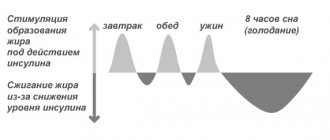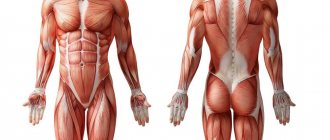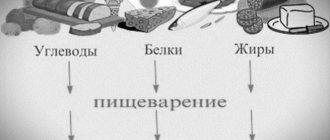Heavy weights aren't that important if you want to get bigger.
Ultimately, the goal should be to injure muscles in the gym and then allow them to grow through nutrition and recovery. And what weight you do it with does not affect the result as much as most people think. How strong do you need to be? Let's take a closer look at this problem. Most people want to lift huge weights. And there's a reason for this - it's a great thrill to lift huge weights and set a personal best in serious exercise. And when it comes to heavy compound exercises such as squats, bench presses, deadlifts and military presses, there should be no “ceiling” to strive for at all. But is there a minimum? Many experts routinely encourage athletes to lift more than their bodyweight. For example, 1.5 x body weight is a deadlift for beginners. Many non-competitive athletes strive to get stronger to improve health, joint function, and bone density—and they look to increased strength as an indicator of their progress. And, naturally, many want to become stronger to satisfy their pride. If you look at it from a health perspective, will you live longer if you bench press 180kg per set rather than 130kg? May be. It's worth thinking about. But there must come a moment when you are already quite satisfied with the result. Returning to the pursuit of size, will a constant progression of load increase muscle size? If you are an advanced athlete, then no. Of course, it helps stimulate the nervous system and release testosterone and growth hormone, but research shows that higher repetition sets produce a very similar hormonal response. Lee Haney said you need to stimulate muscles, not kill them. If you're already at the point where your muscles look pretty impressive, you've succeeded in building your foundation. And if you want to continue to gain muscle mass, it's time to try other methods.
How to strengthen leg muscles at home
Squats are one of the best exercises for increasing the strength of the muscle tissue of the lower extremities. In addition, with its help you can significantly strengthen the muscles of the buttocks at home .
To do this, you need to stand straight and place your feet shoulder-width apart. As you inhale, bend your legs until you get a right angle. As you exhale, you need to return to the starting position. Recommended 2-3 approaches of 8-15 times. Important! Your back should be kept straight when performing squats, and your thighs should be parallel to the floor.
Lunges are no less effective than squats and are widely used among athletes. To perform the exercise, you need to stand straight, put your feet together, and place your palms on your waist. A wide step is taken forward until a right angle is obtained between the lower leg and thigh. You need to hold this position for a few seconds and return to the NP. Then you need to change your leg and perform several approaches 8-10 times.
Running in place is very effective in strengthening muscle tissue and reducing body weight. You need to place your feet hip-width apart and, raising your heels, try to touch your buttocks. It is recommended to repeat at a fast pace about thirty times per set.
The Myth of Progression
People usually refer to progression as increasing the weight that is used for exercises with the same number of repetitions. There's no debate here, but many people don't understand that gaining weight is not the only way to progress. Imagine a typical 10-rep set in a bodybuilder's workout. Before you increase your weight by 5-10% next week, also consider these options:
- Add volume of motion. Increasing the range of motion will increase the time under load with the same weight. For example, perform deadlifts from a stand or partial squats with a greater amplitude.
- Change of pace. Of course, it is much more difficult to lift heavy weights using slow negatives on every rep and set. Paused reps, 4-second negatives, and other tempo changes will create greater stimulation of muscle hypertrophy. This is especially effective for bench press exercises.
- Extended approach methods: rest-pause method, ladder sets, 1.5 reps are just a few ways to increase the load.
Again, if your main goal is muscle growth, you need to change your mindset a little. The concepts of “big” and “strong” overlap quite often, but in many ways they are not the same thing.
How to increase muscle size
If you've been building strength over a long period of time and now want to increase muscle size like a bodybuilder, here are 4 strategies that will work.
Focus on the brain-muscle connection
Many people don't know how important it is to create a mental connection with the weight they're lifting. They bench press dumbbells with very heavy weights and try to maintain proper form so that they can “feel it in their chest.” In truth, you can use lighter weights and increased mental focus to achieve the same thing. You can press dumbbells 2 times lighter, and after a while you will notice that your muscles have grown larger than ever. The main goal should be to make yourself feel like the dumbbells are much heavier than they actually are. At the same time, you will feel the same muscle pain as after performing the exercise with heavier weights. The same rule applies to split squats, lying dumbbell flyes, and lateral dumbbell swings.
Use high volume weeks
Sets of 6-8 repetitions will not work if you do them constantly. They become excessive, and the nervous system responds less and less to this method of training. In this case, “high volume” means more sets and more reps. Take any compound exercise and use a more reps, less rest scheme. You can simply do 6 sets of 10-12 reps with less rest. Or something more advanced and challenging, such as the Gironda 8 x 8 program, or the German 10 x 10 volume training, or ladder sets in which you use no more than 70% of your 1RM. Again, it is important to remember what our main goal is. These workouts are needed to damage and fatigue the muscles, that is, in order to cause their growth during the recovery period.
Use burning sets
Even on weeks when you train with heavier weights, after your last work set, reduce the weight to 60% of your 1RM. Perform 1 set until muscle failure. It should be about 15-20 repetitions. This is a great finisher to a workout, but more importantly, burn sets dramatically increase lactic acid levels and also stimulate a large release of growth hormone from the pituitary gland.
Train intuitively
This is a very simple rule: do not live as a prisoner of your training program.
It's easier to look at your workout routine as a pile of paperwork on your desk that needs to be completed before the end of the day. Papers that are still left on the table mean unfinished work. The point is this: if you practice approaches without the mindset and concentration, feel pain in your joints, and, in principle, do not get any results from the training, then there is no point in doing them. We all have workouts that we don’t “get.” You need to complete such a bad workout, even if you don’t feel anything in the target muscles. It's a true sign of training maturity when you can make changes to your program and do what your body needs at that moment. This could be, for example, replacing lunges with dumbbells with French presses. When you're feeling great on squat day, why not do 1 or 2 extra sets? Take full advantage of the moments when you feel great, but don't forget that there may be times when the opposite is true. Training intuitively means that sometimes you need to ignore the weights you're lifting and focus on the basic pattern and stimulation, like in tip #1. Don't even count the reps. Act strictly according to your feelings. This is why you may sometimes see a veteran bodybuilder come into the gym and do isolation training with light weights. This is a valuable idea.
Good luck!
Causes
There are a number of factors that can cause muscle stiffness, including:
Exercise
A common cause of muscle stiffness is exercise or some form of strenuous physical labor.
Often, stiffness can occur when someone begins a new exercise or program or increases the intensity and duration of the exercise.
When this happens, the muscles have to work harder, which causes microscopic damage to the muscle fibers, causing them to become stiff or sore. This type of injury is sometimes called delayed muscle disease (SDMS).
Any movement can cause DOMS, but it is usually caused by:
- jog or run downhill.
- using weights
- doing squats
- doing push-ups
stretching and deformation
The most common cause of muscle stiffness is a sprain or strain, which can affect both the muscles and ligaments.
A strain is a stretching or tearing of muscle fibers. Strains are especially common in the legs and lower back.
A sprain is a stretch, twist, or tear of a ligament. Ligaments are bands of tissue around joints that connect bones together.
Common areas prone to sprains include:
Other symptoms associated with sprains and sprains include:
Polymyalgia rheumatica
Polymyalgia rheumatica causes muscle pain and stiffness. It usually affects the upper body, including the shoulders, neck and arms. It usually also affects the thighs.
The average age of a person with polymyalgia rheumatism is 70 years old, and some people do not develop it until they are in their 80s. What causes this disease is unknown.
Additional symptoms of polymyalgia include rheumatism:
- sleep disturbance
- difficulty putting on clothes
- problems with changing positions, such as getting up from a chair or car
Bites or stings
Sometimes insect bites and stings can cause muscle stiffness. Bites or stings can also cause a red, swollen lump on the skin that may be itchy and painful.
Bugs that commonly bite or sting and can cause muscle stiffness include the following:
Symptoms of a bite or sting usually improve within a few days, but some people have allergic reactions that may require medical attention.
Stiffness after an insect bite can also be associated with more serious illnesses such as Lyme disease, malaria, or Rocky Mountain spotted fever. These conditions also cause other symptoms such as fever and malaise.
Infections
Some infections cause muscle stiffness in addition to other symptoms. These infections include
- tetanus, a bacterial infection usually associated with dirt or soil.
- meningitis, an infection of the brain and spinal cord.
- HIV
- Legionnaires' disease
- polio
- mononucleosis or mononucleosis.
- lupus
- flu or flu
Medicines
Some medications can cause muscle stiffness. Muscle stiffness is a common side effect of statins, or medications prescribed to lower cholesterol.
Anesthetics used before surgery can also cause muscle stiffness in the hours and days that follow.
Additional reasons
Other factors that can sometimes lead to muscle stiffness include
- lack of daily physical activity
- overweight
- poor nutrition
- doesn't sleep well
- Being in a cold or damp environment.











